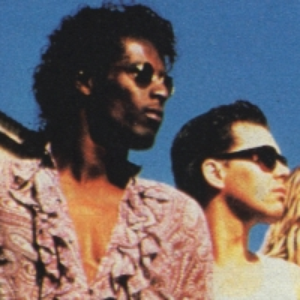
| Trackimage | Playbut | Trackname | Playbut | Trackname |
|---|---|---|---|---|
| 18106932 | Play | Big Bubbles No Troubles | 04:39 Tools | |
| 18106934 | Play | Big Bubbles, No Troubles | 00:00 Tools | |
| 18106933 | Play | Big Bubbles No Troubles (Bubbles Mix) | 04:47 Tools | |
| 18106939 | Play | Where Did Tomorrow Go? | 04:08 Tools | |
| 18106935 | Play | Ju Ju Goodbye | 04:44 Tools | |
| 18106938 | Play | Hungry Man | 04:22 Tools | |
| 18106936 | Play | Two Lonely Hearts | 02:53 Tools | |
| 18106937 | Play | Bad Times | 04:48 Tools | |
| 18106942 | Play | Homelands | 06:31 Tools | |
| 18106956 | Play | Say A Prayer | 03:07 Tools | |
| 18106950 | Play | I Would Die For You | 04:22 Tools | |
| 56595622 | Play | Big bubbles, No troubles (bubble mix) | 04:22 Tools | |
| 18106940 | Play | Why Does Living (Become A Crime)? | 04:00 Tools | |
| 56595623 | Play | Where Did Tomorrow Go | 04:22 Tools | |
| 56595624 | Play | Why does living | 04:00 Tools | |
| 56595626 | Play | Big Bubble No Trouble | 04:48 Tools | |
| 56595625 | Play | Big Bubbles, No Troubles (Extended) | 04:00 Tools | |
| 18106963 | Play | Big Bubbles No Troubles (Bubble Mix) | 04:48 Tools | |
| 18106961 | Play | Rock Me (Block Mix) | 05:17 Tools | |
| 18106953 | Play | Big Bubbles No Troubles (Bubbl | 04:47 Tools | |
| 77138339 | Play | Big Bubbles, No Troubles (Rubble Mix) | 03:31 Tools | |
| 18106941 | Play | 08. Big Bubbles No Troubles | 03:31 Tools | |
| 56595627 | Play | Big Bubbles, No Troubles (remaster) | 03:33 Tools | |
| 56595628 | Play | Big Bubbles No Trouble | 03:31 Tools |

-
- 2,778
- plays
-
- 687
- listners
-
- 2778
- top track count
Ellis Beggs & Howard were an English rock band (1987 - 1990). The original demo tapes for the group were recorded in North London at their management's building, the PARC tower. PARC were a leading management company, being the sole representatives of Terence Trent D'Arby, who at the time was a major act. The managers were both German: K.P.Schleinitz and Stefan "Luxi" Lux. Originally, EBH were made up of Simon Ellis (keyboards and programming), Nick Beggs (bass and Chapman stick), and Austin Howard (vocals). They were augmented by Paul Harvey on guitar and Robbie France on drums. (Although Harvey played on the PARC tapes, France did not.) Although they experimented with several other guitarists, including Marty Williamson, Keith Airey and Sabu Bugaban, that was the essential line up. These were the 'fab five'. ==The early tours== EBH started in late 1987 by playing a few low-key gigs in London. They featured in the NME-sponsored shows at The Greyhound in Fulham, and a high-powered performance at the nightclub Heaven, but it was in the big arenas that they rose to the occasion with a combination of programming and live performance (e.g. supporting T'pau). Initially, the press were sceptical about the merits of the band, simply because of Nick Beggs' link with Kajagoogoo, the iconic pop band of several years before. Also, because the band were managed by PARC Management, the critics mistakenly hinted that it was built more on hype than on substance. EBH quickly found success in continental Europe. Their first single, "Big Bubbles, No Troubles", was a hit, receiving several awards in many of countries, though without much success in England (it reached number 41 in the UK charts). After they appeared on the Night Network television show, the press was inundated with critical mail, often accusing them of miming. ==The second album== After the failure of their first album ''Homelands'', in the United Kingdom, and despite it success elsewhere in Europe, tensions in the band became overwhelming. Their record company, BMG, seemed to be ignoring the band's several major touring and recording successes, and it was rumoured that EBH and PARC were looking for a way out of the contract in favour of a more supportive label. Nevertheless, from 1989 they recorded the basic tracks of what was to have been their second album with the Fleetwood Mac Mobile, at the Easi Hire rehearsal complex in London. With the band and record company tearing each other apart, the album was never released by a label, although Beggs made it available several years later as a "home-grown" CD release entitled "The Lost Years Vol. 1". The album is notable for contributions from musical luminaries Warren Cuccurullo and Robert Fripp. Once EB&H called it a day, Beggs went on to join Íona. He has since worked with a number of artists, as well as producing solo material. Simon Ellis became musical director for a number of high-profile acts such as The Spice Girls and S Club 7 (for whom he co-wrote the song "Don't Stop Movin'"), and Howard has pursued a solo career. Read more on Last.fm. User-contributed text is available under the Creative Commons By-SA License; additional terms may apply.